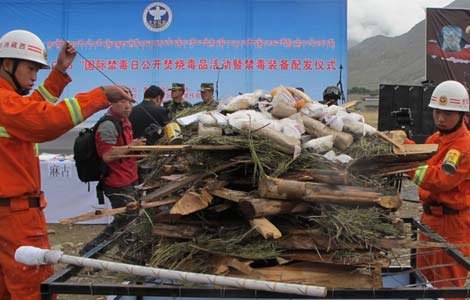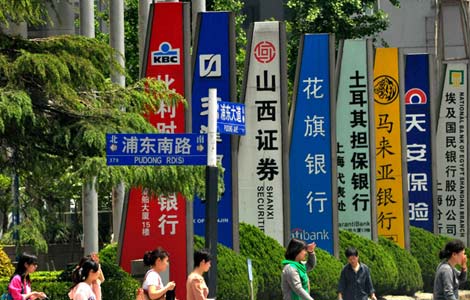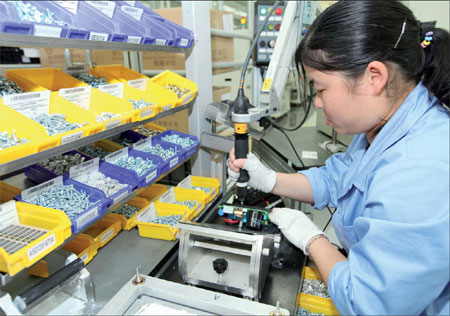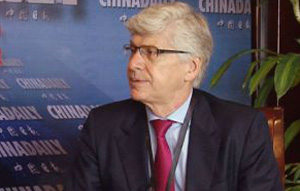Siemens gets smart
Updated: 2013-06-12 13:39
By Meng Jing (China Daily)
|
||||||||
|
Siemens searches Chinese companies for unique products, components that can be integrated into its array of wares. Provided to China Daily |
Chinese technologies have helped company gain a bigger share of Asian market
A competent headhunter may read hundreds of resumes before matching the right person with the right position. Li Ming's job at Siemens AG, a global powerhouse in electronics and electrical engineering, is a lot like a headhunter. But instead of poaching talent, she hunts for startup technologies.
Li, a director at Siemens Corporate Technology in China, researches Chinese companies looking for unique products, most of which are components that can be integrated into Siemens' array of wares. She has brought 19 external technologies to Siemens since 2005, the year the company opened a division in Shanghai.
By matching the right technology with Siemens' products, Li's department, one of the company's three technology-to-business centers in the world, has not only helped Siemens lower production costs but it has also saved the company arduous months and years spent on research and development.
The technology-to-business center is part and parcel of Siemens' strategy to create SMART products (a company-coined term that stands for simple, maintenance-friendly, affordable, reliable and timely to market). To do so, the German conglomerate is tapping into price-sensitive markets in emerging economies such as China, Siemens' main target.
"For us, China is not only the largest market in emerging economies; we also want to build China into a major R&D center and manufacturing base to meet the demands in other emerging economies," says Kenneth Hsu, vice-president of Siemens China, adding that SMART innovation is the company's strategy to gain a leading position in emerging markets such as China.
The ongoing global economic recession, including a continued slowdown in China's economy, has led to a 7 percent drop from the previous year in Siemens' second quarter revenue for fiscal year 2013. According to its financial report, revenue in China declined by 2 percent from the previous year, compared with a 12 percent decline in the Americas and a 6 percent drop in Germany.
It is clear after talking to company representatives that meeting the demand in emerging markets is critical to the company's future success. For the past century, Siemens has relied on high-end, feature-rich products developed in the West. But when Arding Hsu took over as head of corporate technology with Siemens China in late 2004, his first instinct was to change its innovation model from one based on the West to one that is focused on the Far East.
"There is no country in the world that has as many diversified demands as China," he says. "As long as we can better understand the needs of Chinese customers, there is a better chance of us becoming the game changer in the market."
One difference in Siemens' innovation strategy is that while its R&D centers in Germany and the US focus on making products more sophisticated, its Chinese center looks to create simplified solutions for Chinese customers.
One of the major examples of the company's SMART innovation strategy is a simple music player his wife has been using to learn how to sing.
"In the US, people usually use iTunes to download music, and they also need to buy a specially made speaker for their iPods, which can cost nearly 2,000 yuan ($326; 253 euros)," says Arding Hsu. "But in China, we have a speaker for around 90 yuan where you can simply fill your memory stick with songs and plug it in. It's not only simple but a lot cheaper."
Kenneth Hsu says many Chinese customers don't need top-end products and are satified with the "good enough". In the automation sector, the total market size in China in 2011 was about 34.5 billion yuan, of which 47 percent was for middle to high-end products, while 53 percent came from lower-end varieties.
Siemens' changes are not only happening in its innovation sector. To better implement its SMART strategy, it is fine-tuning its product chain - from innovation and manufacturing divisions down to its sales and after-sales services - especially for China. Between fiscal year 2010 and fiscal year 2013, it will have invested more than 400 million euros in expanding manufacturing facilities in China.
Chinese companies are extolling Siemens' new direction in China. Ding Zhenning,a section manager with the Nanjing No2 MTWS CNC Lathe Co., says that its products, which use Siemens' numeric control systems, have experienced a rapid rise in sales after the German company launched its first SMART numeric control system - called the Sinumerik 808D - in 2012.
Ding says that out of the 2,000 machine tools his company produces every year, about 60 percent use Siemens' numeric control systems. Its share of its niche market had been 30 percent.
"Many of our clients were reluctant to buy machine tools with Siemens numeric control systems because they are very expensive and complicated to use," Ding says. "The price of a Sinumerik 808D is still a little bit higher compared with its Chinese counterparts, but the much better performances of Siemens' products has helped the company win more and more customers in the middle and low-end markets."
No one is sure how much revenue SMART products have generated for Siemens. Its SMART divisions have more than 160 products, a comparatively small number to the company's total of 100,000, but Kenneth Hsu says the sales growth of its SMART products beats the sales rate of its traditional products.
The majority of its SMART products, from fire alarms in its infrastructure and cities sector to computed tomography equipment in the company's healthcare sector, are exported to both emerging economies and developed countries.
But for Arding Hsu, stellar market performance in China is only one consequence of the company's SMART innovation. With diverse demands in China's large market, Hsu hopes that his department can one day come up with a product that can become a global game changer.
"The reason that Apple Inc and its tablets can be successful is because they deeply understand the demands of people," he says. "With so many different market demands in China, and with so much inspiration in the country, we believe we can be very successful in the future if we keep focus on the needs of Chinese customers."
mengjing@chinadaily.com.cn
(China Daily USA 06/12/2013 page15)

 Philippine, US start Naval exercise in S China Sea
Philippine, US start Naval exercise in S China Sea
 Supreme Court gay rights ruling celebrated across US
Supreme Court gay rights ruling celebrated across US
 Rudd returns as Australian PM after Gillard
Rudd returns as Australian PM after Gillard
 Brazil protests intensify before Confed Cup semifinal
Brazil protests intensify before Confed Cup semifinal
 Long lost weekend
Long lost weekend
 Park ready to charm China
Park ready to charm China
 Prices climb as police crack down
Prices climb as police crack down
 China 'most promising' in FDI
China 'most promising' in FDI
Most Viewed
Editor's Picks

|

|

|

|

|

|
Today's Top News
Proposed law puts curbs on family visas
Markets will stay volatile, continue to struggle: Expert
Promising outlook on US, China investment
US adoptees visit Chinese roots
Ecuador refutes Washington Post accusation
IBM to make Chinese job cuts
PBOC ends credit crunch, to go further
Snowden still at Moscow's airport, asylum pending
US Weekly

|

|








